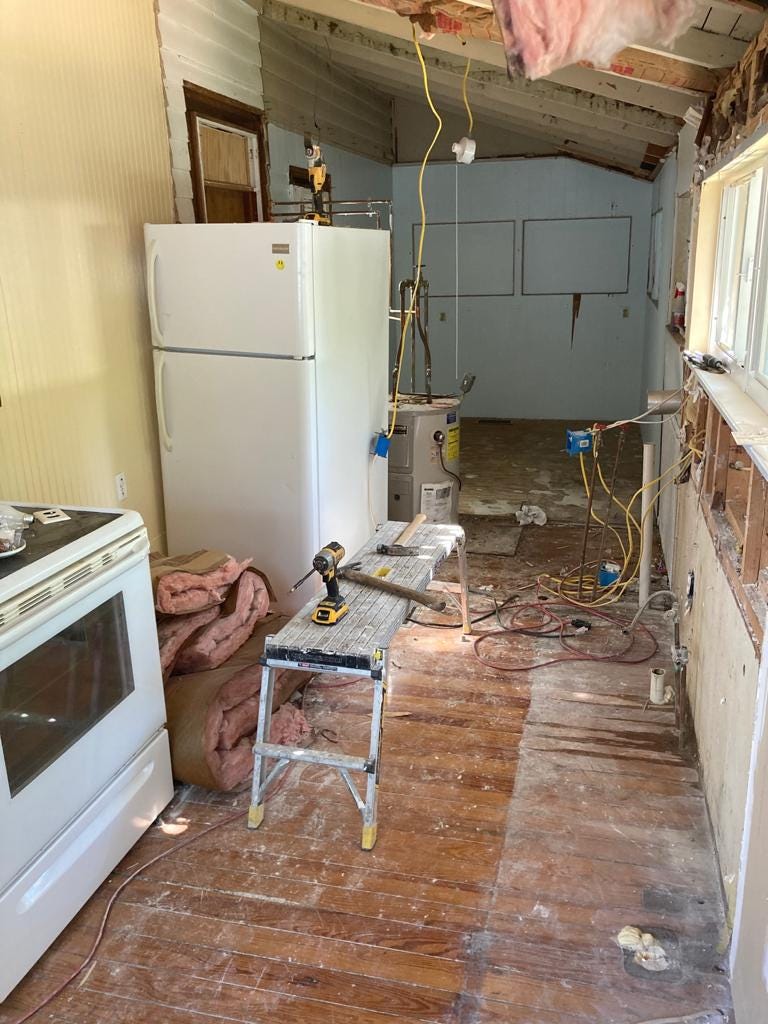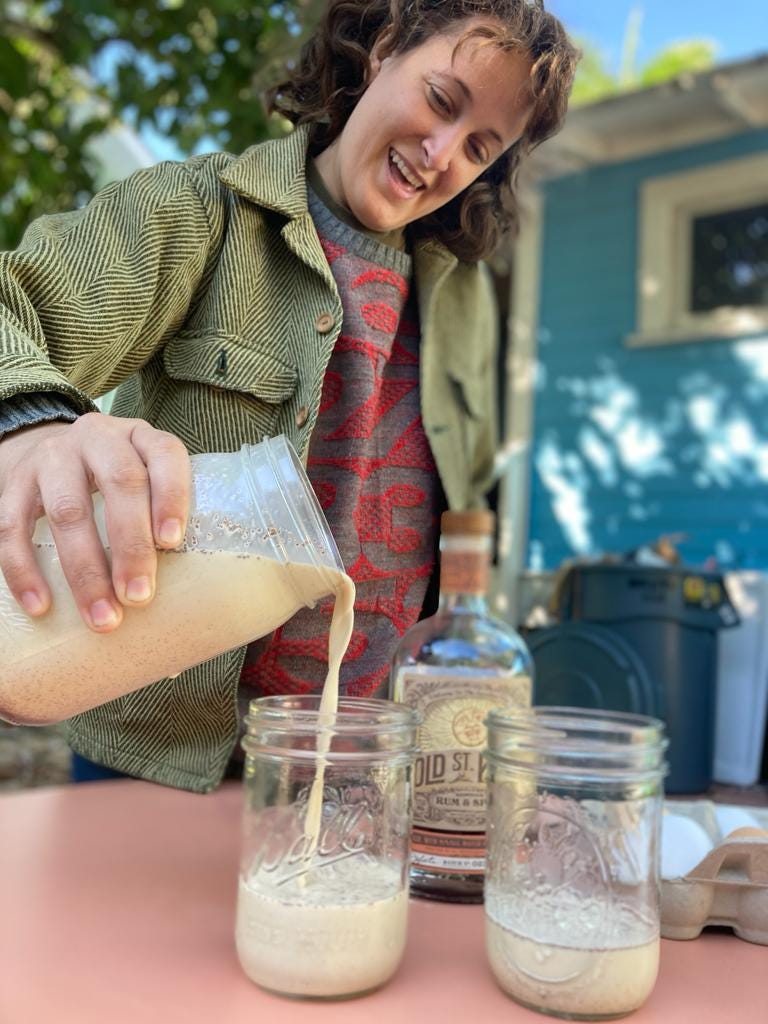Our penultimate issue of 2020! And howdy and a warm welcome to our new subscribers! Today we’re talking kitchen appliances, kimchi, the great mason jar shortage of 2020, and the best way to keep eggs and milk fresh forever (…with copious amounts of alcohol ).
I am currently 10 days into what will end up being more than a month without a kitchen. I’m fermenting veggies on my porch, washing dishes with a hose in the front yard, and eating out for most of my meals 😓
🛠️MY KITCHEN FIXER UPPER🛠️
My beautiful old house came with a Polly Pocket-sized kitchen — completely untenable for someone that cooks as much as I do. In 2021 I will be starting a bakery-ish business (details soon!), and I’ve decided to do it from inside my house. When everything I own is covered in flour, I may regret that decision, but here we are! After the renovation I will have almost doubled the square footage of the kitchen (I’m robbing from the too-big laundry room). There will be heaps of storage, a big butcher block prep table, two refrigerators, and three ovens (a Rofco electric deck oven for bread, an induction range/convection oven for normal stuff, and an outdoor wood-fired oven for fun, and because a friend offered to design and build it with me!).
After increasing functionality, improved resource efficiency was a major goal of the renovation. So step one was donating most of my older, inefficient appliances to the Habitat for Humanity Restore and choosing new, energy efficient models. While it’s true that the electricity consumption of my refrigerator is not a big deal in the grand scheme of climate change, it is a sizable portion of my personal carbon footprint (around 10% of energy use in a typical home).
One of the bigger decisions I made was to go dryer-free. Out of the three appliances that require the most energy (along with the fridge and washing machine), the dryer is the one I can live without. I will hang my clothes to dry, which is not a big deal in sunny Florida. Until I have children, at which point I will most definitely get a dryer (children are filthy!). For the can’t-live-without appliances, I spent hours scouring Energy Star guides for the lowest kWh (estimated yearly electricity consumption), researching just how much water a dishwasher actually uses, and agonizing over whether to spring for an induction range.
🥖BUILDING A BAKERY🥖
Now you might be thinking to yourself, “it doesn’t matter how energy efficient your appliances are, you’re going to have two fridges and three ovens!!!” And you would be correct. The carbon footprint of my kitchen will still be relatively massive. But since I’ll be baking bread and other goodies for upwards of 50 people (fingers crossed!!), my future customers will be sharing the carbon cost with me.
Being able to invest in a business by renovating my kitchen is not something everyone can do, and I recognize that privilege. I hope that by nourishing people with heaps of sweet, sweet gluten, I will be providing a valuable service, in my own small way. I’m excited to watch the process unfold, and so ready to once again have a kitchen sink.
📸PROGRESS PHOTOS📸
Here are some photos from Week 1 of the Kitchen Renovation. Before and After:

love,
Jackie
Do you have any big projects (or relaxing vacations 🛀) planned for the holidays? Tell us about it!
ICYMI
Need help finding the perfect present? We got you covered 🎁
Our annual holiday gift guide is out! Did you accidentally burn your oven mitts by leaving them on the hot stove? Do you need a fine bottle of whiskey to get through the New Year? We’ve picked out items for any type of crisis. You should definitely take a peek at the full list.
Do you have a food-related present that we should know about? Share with us your favorite gifts for the kitchen and garden at sunshineandmicrobes@gmail.com!
Fresh Links 👇
🇰🇷 Kimchi Making at Home Was Going Out of Style. Rural Towns to the Rescue. | NY Times
Kimchi is so connected with Korean identity that a jar of the spicy, fermented napa cabbage pickle was sent to the International Space Station alongside the first South Korean astronaut in 2008. In front of the camera, Koreans say “Kimchiiii,” instead of “cheese.” Koreans love eating kimchi, but making it is another story.
According to the World Kimchi Institute, 4 in 10 Korean households have never made kimchi, and factory-made kimchi (38 percent of which is imported from China) is the most ubiquitous option. But many Koreans miss the taste of homemade, and are turning to the countryside to keep the tradition of kimjang alive. Kimjang is the annual fall ritual in which families make a year’s worth of kimchi with the help of their community — with singing and plenty of makgeolli (rice wine) to go around.
A group of older residents in White Horse village in rural Goesan county who make kimchi for their urban-dwelling children, kept getting requests from their kids’ neighbors. They saw a business opportunity and started hosting kimchi-making workshops. These workshops blossomed into a three day “kimjang festival”, which saw over 80,000 attendees in 2019. Local farmers provide the ingredients and older residents the expertise. Participants leave with enough kimchi to get them through the next year. During this year’s festivities, families stood around a table and began mixing, “all wearing elbow-length pink rubber gloves, while village meisters looked on and offered tips. Steamed pork and makgeolli were available for free, though singing was banned for safety reasons related to the coronavirus.”
⚗️Why Everyone’s Suddenly Hoarding Mason Jars | Medium
Since the pandemic started, mason jar shortages have been spotted at retailers throughout the country. Companies that sell things like jam can’t find enough to store their product. Online there’s price-gouging (a dozen jars for $50 on Amazon) and flimsy knock-offs (jars shipped from China instead of Indiana and Ohio, where the most famous mason jar brand Ball manufactures its product).
Jen Doll goes deep on the history of mason jars. The use of glass as a way to preserve food started under Napoleon in the 18th Century when the French government offered a 12,000 Franc prize to “ to whoever could invent a food preservation method that would allow reliable transport of food to the far-flung military.” A French chef named Nicolas Appert won, and has subsequently been dubbed the “Father of Canning.” A New Jersey tinsman named John Landis Mason and the Ball brothers created the modernized mason jar in the latter half of the 19th Century.
There is a pattern for when mason jars tend to boom in popularity. In the past decade or so, the vessel has become associated with a hipster aesthetic. However, they’ve always been popular in times of crisis. The ability to can and ferment your own food is a practice that soothes anxieties. Mason jar sales last took off during the 2009 recession. They’ve also been popular around the Great Depression, World War II, and other anxious eras. As Doll puts it, today, “there may be no better barometer of the state of our economy than the mason jar.”*
*Jackie learned this week from two food producer friends that there is also a global glass shortage.
🍳😔 The Joylessness of Cooking | New Yorker
Remember when the challenge of cooking all the time during a pandemic felt like such a fun, creative goal? That was many months ago (and feels like years ago). New Yorker writer Helen Rosner reminds us that after hundreds of quarantine meals, you’re not alone in feeling burnt out. Cooking should be something that’s simple, meditative and frequently innovative, but during times of stress, uncertainty and horror, the satisfaction of a grand meal or learning a new skill can feel “duller and less frequent.”
I’m sure we’ve all grown as chefs during the pandemic. But the obligation of doing it over and over again can wear on anyone. Rosner brings up M. F. K. Fisher’s 1942 book “How to Cook a Wolf”, on cooking and provisioning during World War II (which Jackie wrote about in November!). The difference here is cooking feels less honorable. During the war, the government committed everything to the cause of winning. These days, while we toil away in the kitchen, leaders seem less interested in defeating the pandemic.
Of course, it’s a privilege to even think of cooking as something that should be an unadulterated joy. Still, it’s normal if it feels like a bummer this holiday season. Pick up a meal from a local restaurant, heat up a soup, or outsource cooking to other family members. That’s a gift any regular cook can reward themselves with in December.
Traditional (Everlasting) Eggnog
As a child I carpooled to school with a very unusual girl named Danielle. A quarter century later, Danielle remains one of the most intriguing people I have ever met. She has the brain of an engineer, the heart of an experimental artist, the spirit of an old-timey woodsman, and the energy of a cartoon bunny. Several years ago for Christmas — right before she moved to Portland to explore her passion for pack goats — she gifted me a small jar of her homemade eggnog. I was instructed to keep it in my fridge and take small sips of it over the course of the next year.
Eggnog, which is a concoction of eggs, dairy, sugar, and alcohol, did not strike me as something that would age well. Danielle assured me that the alcohol content was high enough to act as a preservative for the more susceptible-to-spoilage dairy and eggs. And she was right. I couldn’t make the nog last a whole year because I enjoyed it too much, treating myself to little tipples well into springtime.
I’ve been missing that creamy, comforting drink, so I decided to make my own. I checked in with internet food experts to make sure I wouldn’t poison myself, and learned that 20 percent of the total volume is the amount of alcohol needed to keep the eggnog safe. I also learned from Google that two or three weeks ageing in the fridge produces peak nog. I riffed off recipes from Kenji Lopez-Alt, Michael Ruhlman, and Alton Brown (the latter two of which had frat party-levels of alcohol) to create this spiced eggnog. Make a batch soon to enjoy over the holidays and beyond!
Makes 2 quarts (a lot!)
Ingredients and Special Tools
8 eggs (very fresh or pasteurized. No old eggs.)
1 cup granulated sugar
1 teaspoon ground cinnamon
1/2 teaspoon ground nutmeg
1/2 teaspoon ground cardamom
1/2 teaspoon salt
1 cup heavy cream
4 cups whole milk
1 cup dark rum
2/3 cup bourbon
2 teaspoons vanilla extract
stand mixer or handheld electric mixer
step-by-step
Separate egg yolks. Save whites for another use. (They freeze well.)
Combine egg yolks, sugar, salt, and spices and mix with whisk attachment on medium speed for about a minute, until creamy.
Add remaining ingredients and mix on low for another minute or two, until well-combined.
Store in an airtight container in the fridge for up to a year!
Yep, it’s true. This seagull does all his own stunts.
Talk to Us
Send in your comments, mailbag questions, recipe mishaps, or cooking tips: sunshineandmicrobes@gmail.com. Also do us a favor and follow us on Facebook and Instagram. Visit our website and cook yourself something nice.
If you enjoyed this email, please share it with others. If someone forwarded this to you, click the button to sign up:
Sunshine + Microbes team
Jackie Vitale is a cook and kitchen educator based in Stuart, Fla. She is co-founder of the Florida Ferment Fest. Her newsletter explores the intersection of food, culture, environment and community.
Matt Levin is a communications specialist at the ACLU of Texas. He edits Sunshine + Microbes and contributes other scraps to each issue.














